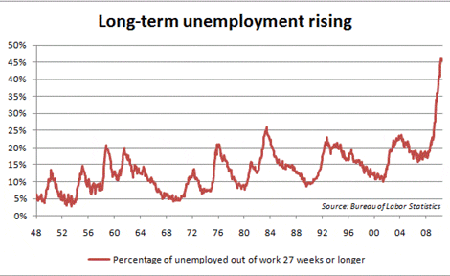US facing structural unemployment
In the US, there is growing concern about the prospect of a double dip recession. The problems in the housing market and the high unemployment rate (which reached 9.5 percent in July) are seen as the biggest obstacles to recovery. Unemployment is set to become a major issue in the mid-term elections. The economy seems stuck in a Catch-22 situation as businesses wait for consumer spending to pick up before hiring and consumers wait for job security before spending.
From the perspective of recovery, a private sector job is considered better than a government job. But unemployment numbers in recent months would have been much worse had it not been for the government hiring hundreds of thousands of temporary workers to conduct the 2010 census. The US census is a once in a decade event so it was fortunate that it came along when it did. But when 143,000 US census workers were laid off in July they overwhelmed the modest increase of 71,000 private sector jobs created the same month.
And many of the unemployed have been out of work for a long time. The diagram below shows that 45 percent of the unemployed have been unemployed for more than 27 weeks – by far the highest level since WWII.

And the official figures do not give a complete picture of unemployment. They do not count "discouraged" workers who have stopped looking for work. Those that are "under employed" are not counted either. Under employed people include those working below their skill levels or part-time workers who want full-time employment. If these were counted, the unemployment rate would be more than 15 percent.
There is growing concern that much of today's US unemployment is what economists call "structural unemployment." This type of unemployment is created when those seeking work do not have the required skills, training or education to do the work that is available. In other words, when there is a mismatch between workers' abilities and unfilled vacancies. For example, IT specialists with experience in the health care industry are in demand in the US. But there are not enough people with the right skills to fill the jobs. On the other side of the coin, many less-skilled jobs may have disappeared forever, for example in the construction industry. Continuing globalization is also a factor as the global wage becomes the local wage. If the global rate for auto workers is $20.00 per hour, then that will become the US rate. And since American automobile workers will not accept that wage-rate, and the associated standard of living, the jobs will go elsewhere.
So, what will it take to bring about a US economic recovery? Certainly, the answer must address the structural unemployment that has resulted from the financial crisis. A related question is "What can the US produce that the rest of the world is willing to buy at an attractive price?" The answer to this question and the need to reeducate and retrain the workforce are critical to solving the US economic dilemma.
Dr. Claggett is a columnist with China.org.cn. For more information please visit: http://fwswk.com/opinion/node_7078635.htm
 0
0 






